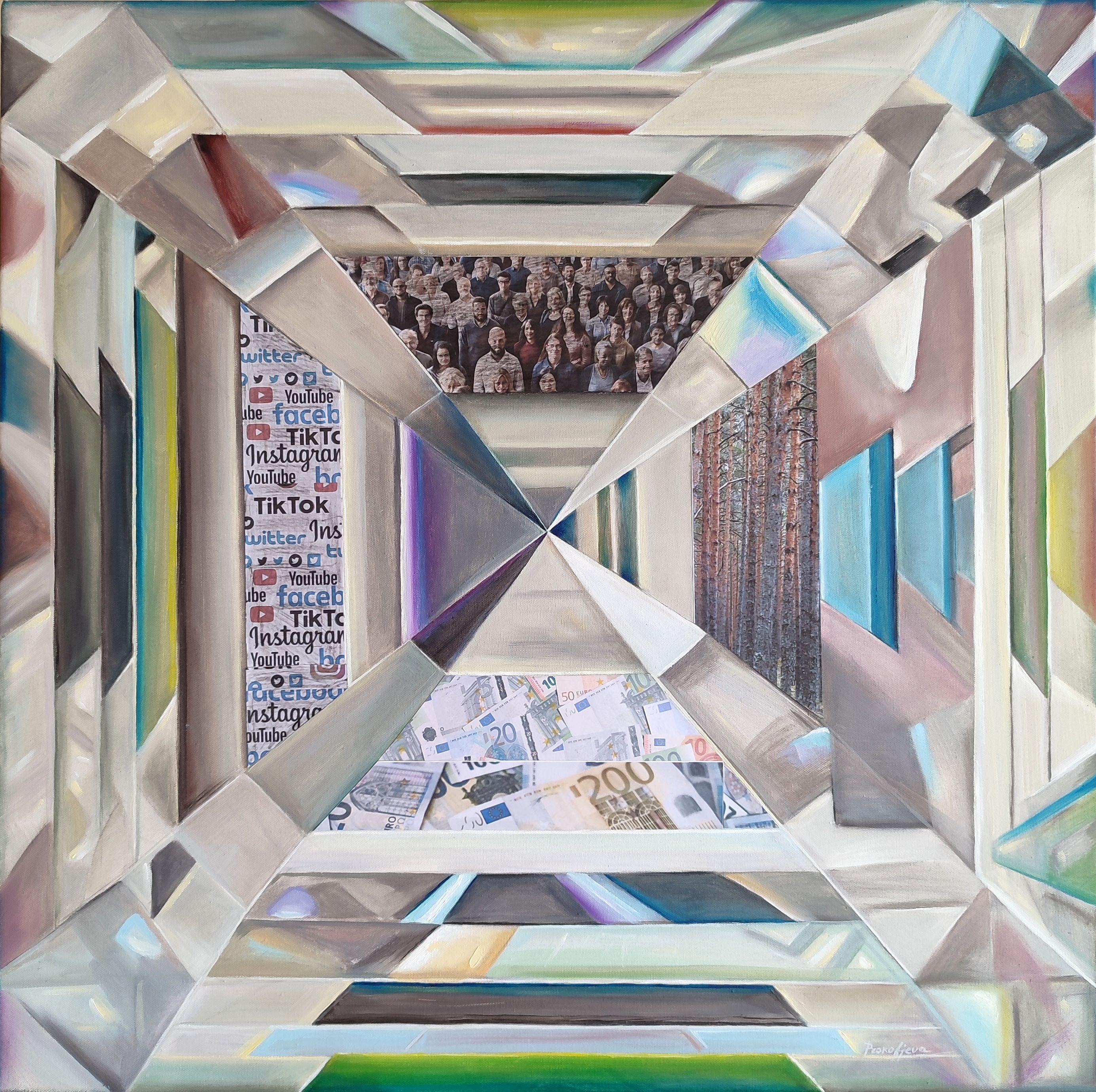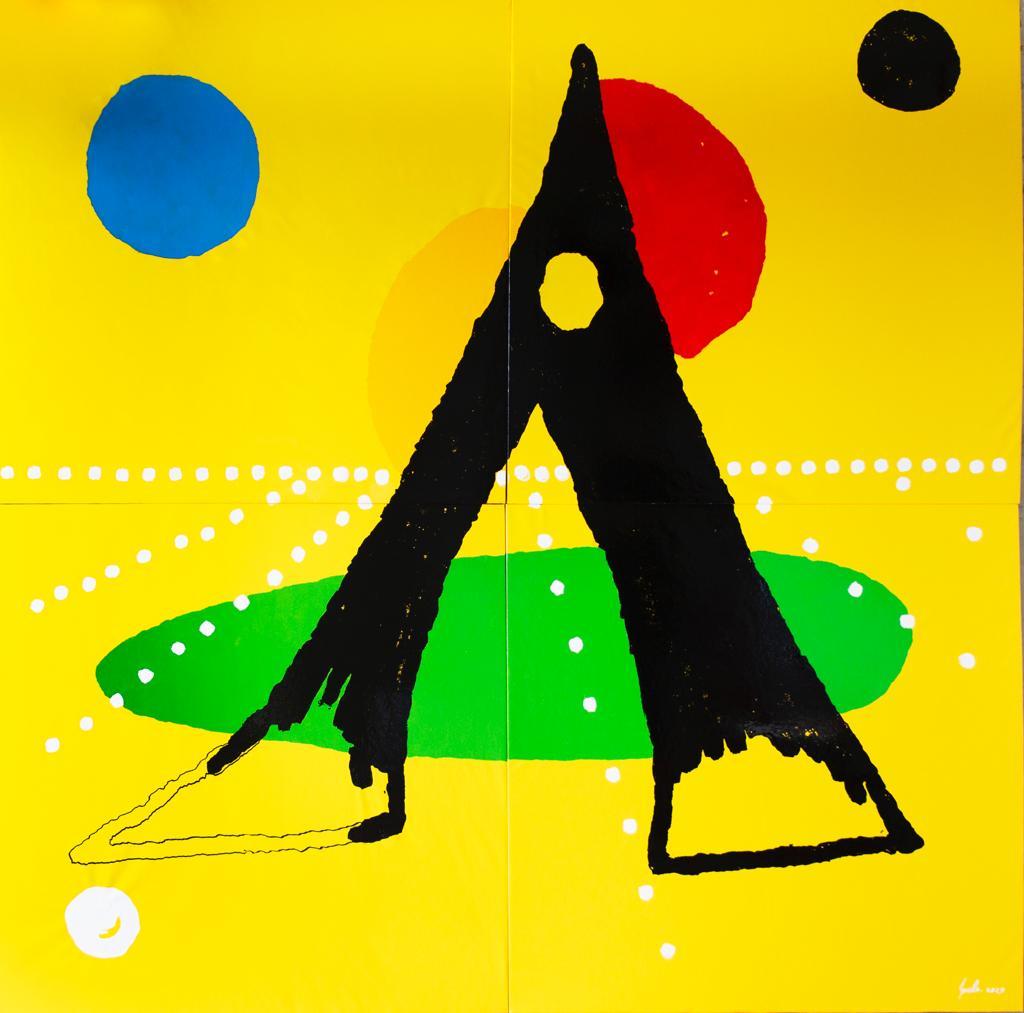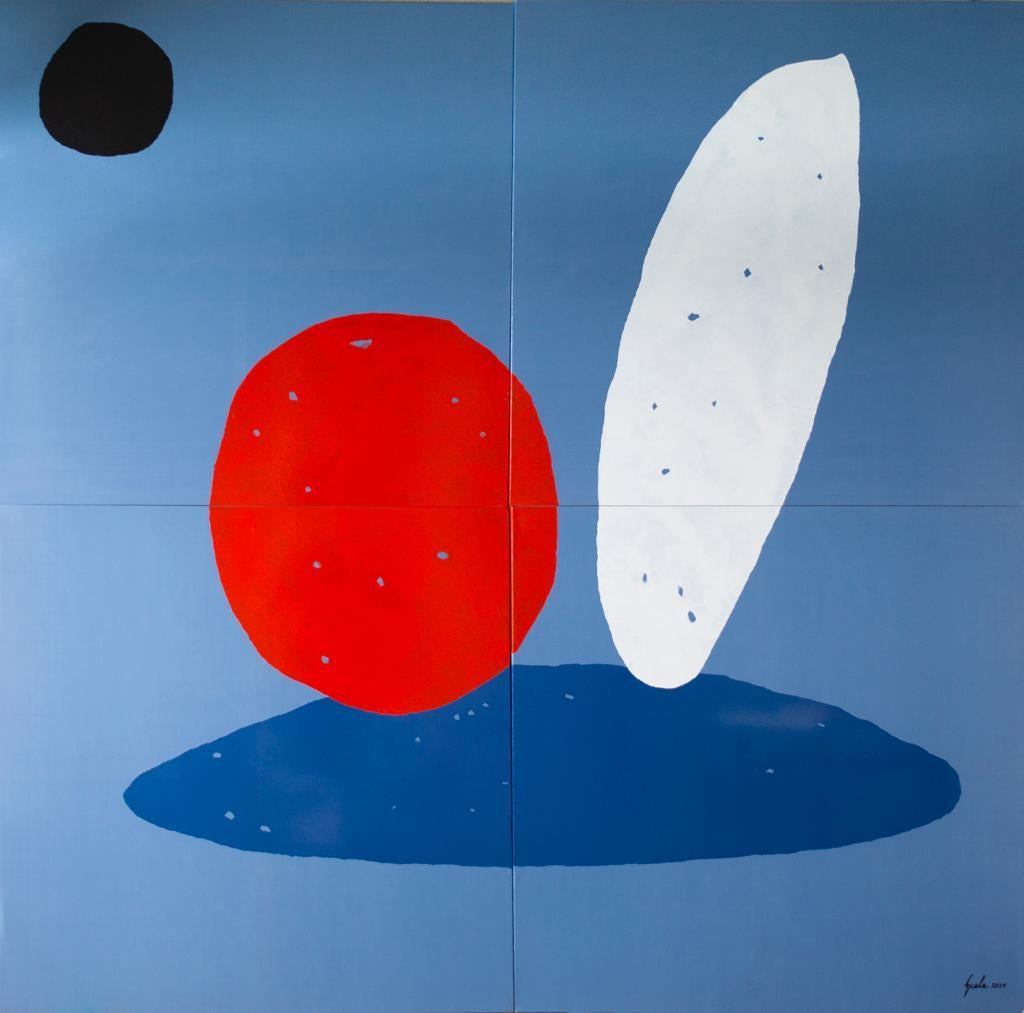Items Similar to "Mirage" Abstract Postwar Oil & marble powder on canvas
Want more images or videos?
Request additional images or videos from the seller
1 of 9
Miyawaki Aiko"Mirage" Abstract Postwar Oil & marble powder on canvas1964
1964
About the Item
Aiko MIYAWAKI graduated from Japan Women's University (Western History Department) in 1952. In 1953, she was introduced to the Western-style painter Nobuya Abe, who taught her the art of Europe and America. From there, she was introduced to artist Yoshishige Saito, who encouraged her to show her art. In 1957, she left to study painting at the University of California and Santa Monica Municipal College. In 1959, she moved to Milan, where she met Enrico Baj, who became her artistic guarantor. She also befriended other great masters of the Italian avant-garde - Lucio Fontana, Enrico Castellani and Piero Manzoni.
Around this time, Miyawaki developed an innovative series in which enamel and marble powder - once mixed with paint - is applied directly to the canvas to create textured and sometimes patterned surfaces. These surfaces, "like dunes", express, in the words of historians, a "tension between transformations and something that remains unchanging". In December 1959, these works were exhibited for the first time at Tokyo's Yoseido Gallery. The artist followed this up in 1961 with another exhibition at Milan's Galleria Minima.
In 1962, another exhibition was held at the Tokyo Gallery. Her paintings attracted the attention of André Schoeller, a French art dealer visiting Japan. Immediately afterwards, the artist signed a contract with Schoeller and moved to Paris to produce her art, which was exhibited there. Miyawaki also met Man Ray, who became her friend and mentor. In 1963, the artist moved to New York, where she had an exhibition in 1964 at the Berta Schaefer Gallery (with Man Ray as foreword to the catalog). Returning to Japan in 1966, the artist gave up painting to take up sculpture. She began by using brass pipes, square steel tubes and copper cylinders - "essentially to investigate movement, the effect of light and the relationship to space".
Miyawaki will develop an innovative series in which enamel and marble powder - once mixed with paint - is applied directly to the canvas to create textured and sometimes patterned surfaces. These surfaces, "like dunes", express, in the words of historians, a "tension between transformations and something that remains unchanging". In December 1959, these works were exhibited for the first time at Tokyo's Yoseido Gallery. The artist followed this up in 1961 with another exhibition at Milan's Galleria Minima. In 1962, another exhibition was held at the Tokyo Gallery. Her paintings attracted the attention of André Schoeller, a French art dealer visiting Japan. Immediately afterwards, the artist signed a contract with Schoeller and moved to Paris to produce his art, which was exhibited there.
Miyawaki also met Man Ray, who became his friend and mentor. In 1963, the artist moved to New York, where she had an exhibition in 1964 at the Berta Schaefer Gallery (with Man Ray as foreword to the catalog). Returning to Japan in 1966, the artist gave up painting to take up sculpture. She began by using brass pipes, square steel tubes and copper cylinders - "essentially to investigate movement, the effect of light and the relationship to space". Her work was immediately exhibited at the Guggenheim Museum in New York, where she received a Purchase Award. This was followed by an exhibition at the Matsuya department store in Tokyo - where she met architect Arata Isozaki (Pritzker Prize 2019), whom she married for the second time in 1972.
Among his sculptures, it is his dynamic, large-scale series from the late 1970s - Utsurohi - that will be best known. Here, the artist seeks to achieve a form that excludes any sculptural weight, using stainless steel piano wire as the material. Here, she would mount thin, swirling metal rods on one or more bases, creating a sensation of movement on the installation site. These sculptures - in perfect dialogue with all the elements of nature - subtly manage to change form, echoing the Japanese concept of Utsuroi ("rapid or ephemeral change"). Miyawaki's monumental Utsuhori work will be dedicated and exhibited outdoors in numerous museums and institutions: Gunma Museum of Modern Art (Takasaki), Nagi Museum of Contemporary Art (Okayama), Museum of Modern Art (Kamakura & Hayama), Parvis de La Défense - Musée des Arts Décoratifs du Palais du Louvre (Paris), Palais des Sports Sant Jordi - Montjuic Olympic Plaza - Fundacio Miro (Barcelona), and Pitman Sculpture Garden (Houston). Miyawaki was honored for her innovation in contemporary Japanese art by the Japan Arts Foundation, and in 2003 (among many other awards and decorations) received the Ordre des Arts et des Lettres from the French Ministry of Culture.
- Creator:Miyawaki Aiko (1929 - 2014, Japanese)
- Creation Year:1964
- Dimensions:Height: 21.26 in (54 cm)Width: 21.26 in (54 cm)
- Medium:
- Movement & Style:
- Period:
- Condition:
- Gallery Location:PARIS, FR
- Reference Number:1stDibs: LU2572212720522
About the Seller
No Reviews Yet
Vetted Seller
These experienced sellers undergo a comprehensive evaluation by our team of in-house experts.
1stDibs seller since 2023
- ShippingRetrieving quote...Ships From: Paris, France
- Return PolicyA return for this item may be initiated within 7 days of delivery.
More From This SellerView All
- Pegomas by Kimura Chuta, Abstract Impressionism, New School of ParisLocated in PARIS, FRChuta KIMURA (also "Tchuta" or "Tshuta") is an allusive landscape painter and pastellist. His name - composed of the words Ki (tree) and Mura (village) -...Category
1980s Abstract Landscape Paintings
MaterialsOil
- Deux villageois by Kimura Chuta, Abstract Impressionism, New School of ParisLocated in PARIS, FRChuta KIMURA (also "Tchuta" or "Tshuta") is an allusive landscape painter and pastellist. His name - composed of the words Ki (tree) and Mura (village) -...Category
1970s Abstract Landscape Paintings
MaterialsOil
- Sans titre by Kimura Chuta, Abstract Impressionism, New School of ParisLocated in PARIS, FRChuta KIMURA (also "Tchuta" or "Tshuta") is an allusive landscape painter and pastellist. His name - composed of the words Ki (tree) and Mura (village) -...Category
1980s Abstract Landscape Paintings
MaterialsOil
- Road by Kimura Chuta, Abstract Impressionism, New School of ParisLocated in PARIS, FRChuta KIMURA (also "Tchuta" or "Tshuta") is an allusive landscape painter and pastellist. His name - composed of the words Ki (tree) and Mura (village) -...Category
1980s Abstract Landscape Paintings
MaterialsOil
- "Work" Abstract Postwar Avant-Garde, Oil on canvasLocated in PARIS, FRAiko MIYAWAKI graduated from Japan Women's University (Western History Department) in 1952. In 1953, she was introduced to the Western-style painter Nob...Category
Mid-20th Century Abstract Abstract Paintings
MaterialsOil
- "Color Interlude", Abstract Expressionism, Lyrical Abstraction by Lea NikelLocated in PARIS, FRLea Nikel was a prominent Israeli artist known for her distinctive style and significant contributions to the world of art. Born in 1918 in the city of Tarnopol (now Ternopil, Ukrain...Category
1960s Abstract Expressionist Abstract Paintings
MaterialsOil
You May Also Like
- Subconscious N0507.16Located in New York, NYA painting on wood panel, 96x72". Known for his erratic and expressive abstract works, Daniel Diaz-Tai uses various mixed media including sumi ink and...Category
2010s Abstract Abstract Paintings
MaterialsWood Panel, Ink, Sumi Ink, Oil
- Everyone has their own treasure. 2023 oil, collage, canvas, 70x70 cmLocated in Riga, LVEveryone has their own treasure. 2023 oil, collage, canvas, 70x70 cm In this artwork, author highlight 4 values that have the most power nowadays. Nature, people, money, social med...Category
2010s Abstract Abstract Paintings
MaterialsCanvas, Oil
- "Untitled 1" Painting 102" x 102" inch by GUELA TSOULADZELocated in Culver City, CA"Untitled 1" Painting 102" x 102" inch by GUELA TSOULADZE Oil painting on oilcloth canvases. ABOUT THE ARTIST: Nomad from birth, Guela Tsouladzé was born on November 8, 1959 in Tbilisi, Georgia, from a French mother and a Georgian father. His father was one of the first Georgian psychanalyst; but working with the conscient and subconscient of the homo sovieticus was a disputed occupation, criticized by the soviet ideology. Therefore, it required a significant dose of audacity; it’s in this context of insubordination and freedom, that Guela tirelessly repeats that he will be an artist, without ever having painted anything. The father thus commissioned his first work: a black dot on the ceiling of his office, which his patients would fix during the sessions. The gateway to hypnosis, and the artist’s future signature. Perhaps Guela's innate sense of daring and escapism comes from there; these two themes are till today reflected in his works. Guela grows up in a surreal artistic universe, between France and Georgia, inspired in particular by Pirosmani, the brothers Zdanevitch and Salvador Dali, whom he met shortly before his death in 1981 at Portiligat Cadaques, and surrounded by the filmmaker Paradjanov, a friend of the Tsouladze family. He begins his studies at the Fine Arts on Tbilisi in 1977, but the ultimate horizon is Paris. He joins the Art Décoratifs from 1980 to 1983 and then the Beaux-Arts from 1983 to 1985. He becomes the assistant of Christian Boltanski, whom he follows from exhibition to exhibition. In France, the 80s are colorful years, wild like a Fauvist painting. Art comes out of museums and gives birth to the free figuration, an elusive movement, which was slowly taking shape in the lethargy of the Beaux-Arts. Pop culture, in its spontaneity and in its lack of self-control, takes over everything and breaks down all codes, groups and borders. Art is free from all constraints and analysis. Guela is there at the right time, in the right place, with the right people. The Holy Trinity, as he likes to repeat. These crazy years are an ecstatic playground for his artistic instincts. Guela paints on everything: papers, canvases or newspapers. His grand formats are at the scale of his silhouette; he leaves the Beaux-Art and joins the first squats in the nineteenth arrondissement of Paris, notably the Quai de Seine workshop, which he shares with Remy Blanchard and Vincent Scali. These are the years of Ben, of the Di Rosa brothers, of Robert Combas and François Boisrond. Art for everyone, and party for all. Guela follows his intuitions to Ibiza and Barcelona from 1987 to 1993, where he works at the Casa Caritad, which will later become the city's Museum of Modern Art. This colorful and collective delight contrasts with the dark anxieties of our time. Contrary to the widespread dystopia, it was then the utopia that reigned! New York is its epicenter, shaped by Basquiat and Keith Haring. Guela lives there from 1993 to 1998, including several years at the legendary Chelsea Hotel, of which he covers the walls and furniture with Georgian calligraphy. This is where his simplistic, black, and loving figures were born, later becoming his trademark and one of the symbols of Batumi. It was precisely at the end of the 90s that his desire to build bridges between his native country and France became deeper. The Soviet Union died in a burst of freedom, and the Georgians slowly come out of a fratricidal war, fueled by Russia. Georgia needs love, so Guela replaces the flag’s crosses with hearts, following the 2003 Rose Revolution. Since then, convinced that art is the answer to the stress that is still plaguing Georgia, Guela multiplies projects for exhibitions, partnerships, festivals and art centers. He brings several French artists to the Garikula Residency, including Jean Dupuy...Category
21st Century and Contemporary Abstract Abstract Paintings
MaterialsCanvas, Oil
- "Untitled 2" Painting 102" x 102" inch by GUELA TSOULADZELocated in Culver City, CA"Untitled 2" Painting 102" x 102" inch by GUELA TSOULADZE Oil painting on oilcloth canvases. ABOUT THE ARTIST: Nomad from birth, Guela Tsouladzé was born on November 8, 1959 in Tbilisi, Georgia, from a French mother and a Georgian father. His father was one of the first Georgian psychanalyst; but working with the conscient and subconscient of the homo sovieticus was a disputed occupation, criticized by the soviet ideology. Therefore, it required a significant dose of audacity; it’s in this context of insubordination and freedom, that Guela tirelessly repeats that he will be an artist, without ever having painted anything. The father thus commissioned his first work: a black dot on the ceiling of his office, which his patients would fix during the sessions. The gateway to hypnosis, and the artist’s future signature. Perhaps Guela's innate sense of daring and escapism comes from there; these two themes are till today reflected in his works. Guela grows up in a surreal artistic universe, between France and Georgia, inspired in particular by Pirosmani, the brothers Zdanevitch and Salvador Dali, whom he met shortly before his death in 1981 at Portiligat Cadaques, and surrounded by the filmmaker Paradjanov, a friend of the Tsouladze family. He begins his studies at the Fine Arts on Tbilisi in 1977, but the ultimate horizon is Paris. He joins the Art Décoratifs from 1980 to 1983 and then the Beaux-Arts from 1983 to 1985. He becomes the assistant of Christian Boltanski, whom he follows from exhibition to exhibition. In France, the 80s are colorful years, wild like a Fauvist painting. Art comes out of museums and gives birth to the free figuration, an elusive movement, which was slowly taking shape in the lethargy of the Beaux-Arts. Pop culture, in its spontaneity and in its lack of self-control, takes over everything and breaks down all codes, groups and borders. Art is free from all constraints and analysis. Guela is there at the right time, in the right place, with the right people. The Holy Trinity, as he likes to repeat. These crazy years are an ecstatic playground for his artistic instincts. Guela paints on everything: papers, canvases or newspapers. His grand formats are at the scale of his silhouette; he leaves the Beaux-Art and joins the first squats in the nineteenth arrondissement of Paris, notably the Quai de Seine workshop, which he shares with Remy Blanchard and Vincent Scali. These are the years of Ben, of the Di Rosa brothers, of Robert Combas and François Boisrond. Art for everyone, and party for all. Guela follows his intuitions to Ibiza and Barcelona from 1987 to 1993, where he works at the Casa Caritad, which will later become the city's Museum of Modern Art. This colorful and collective delight contrasts with the dark anxieties of our time. Contrary to the widespread dystopia, it was then the utopia that reigned! New York is its epicenter, shaped by Basquiat and Keith Haring. Guela lives there from 1993 to 1998, including several years at the legendary Chelsea Hotel, of which he covers the walls and furniture with Georgian calligraphy. This is where his simplistic, black, and loving figures were born, later becoming his trademark and one of the symbols of Batumi. It was precisely at the end of the 90s that his desire to build bridges between his native country and France became deeper. The Soviet Union died in a burst of freedom, and the Georgians slowly come out of a fratricidal war, fueled by Russia. Georgia needs love, so Guela replaces the flag’s crosses with hearts, following the 2003 Rose Revolution. Since then, convinced that art is the answer to the stress that is still plaguing Georgia, Guela multiplies projects for exhibitions, partnerships, festivals and art centers. He brings several French artists to the Garikula Residency, including Jean Dupuy...Category
21st Century and Contemporary Abstract Abstract Paintings
MaterialsCanvas, Oil
- Mushroom rain mantra. 2002, oil on canvas, 95, 5x90, 5 cmBy Igor LeontievLocated in Riga, LVMushroom rain mantra. 2002, oil on canvas, 95,5x90,5 cm Abstract composition in earth colors Igor Leontiev (1957) - one of the leading independent painters in Latvia Born in Riga, ...Category
Early 2000s Abstract Abstract Paintings
MaterialsCanvas, Oil
- Quiet water sound. 2018, canvas, oil, 63x128 cmBy Igor LeontievLocated in Riga, LVQuiet water sound. 2018, canvas, oil, 63x128 cm Abstract composition in earth colors Igor Leontiev (1957) - one of the leading independent painters in L...Category
2010s Abstract Abstract Paintings
MaterialsCanvas, Oil



